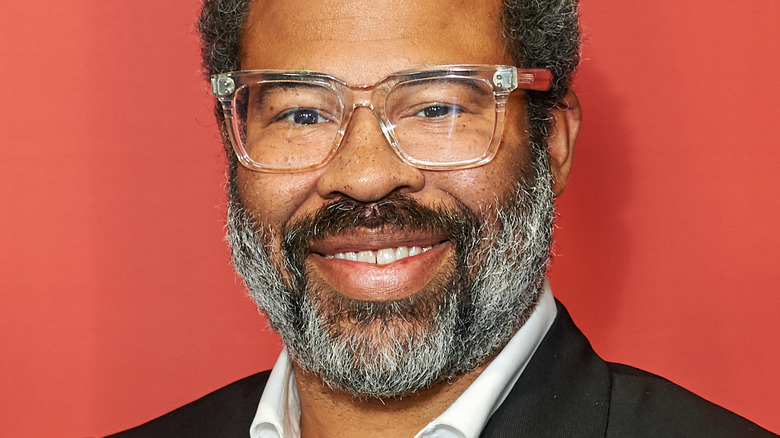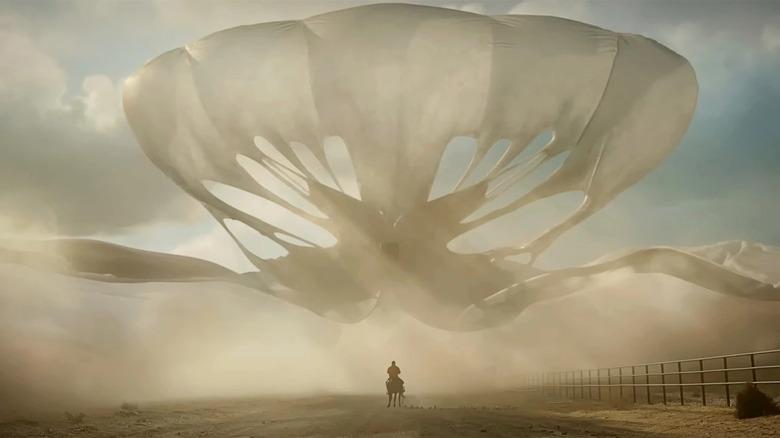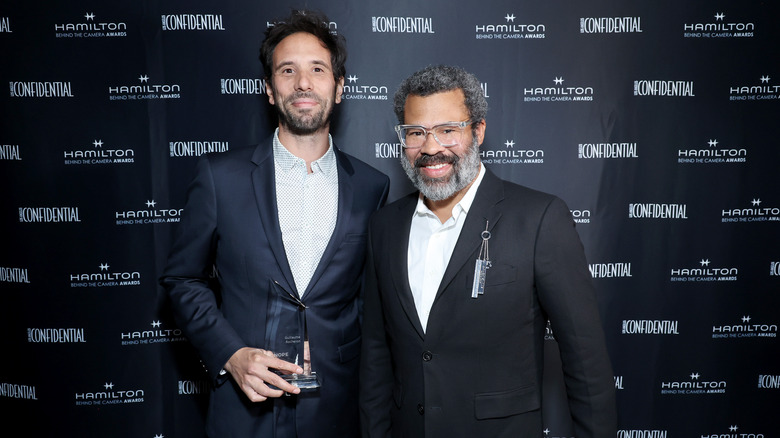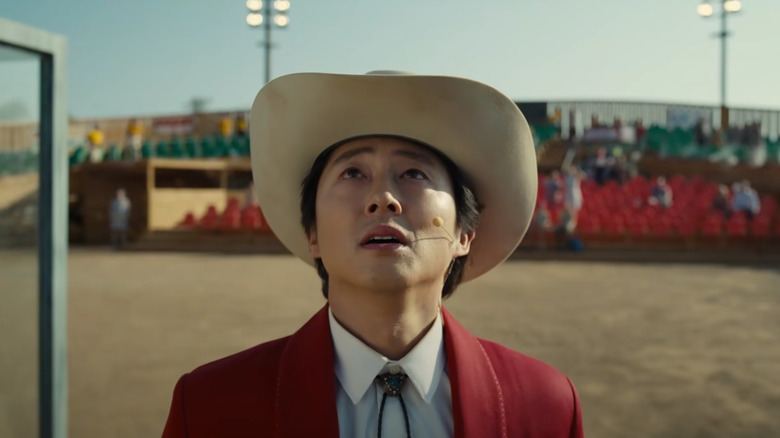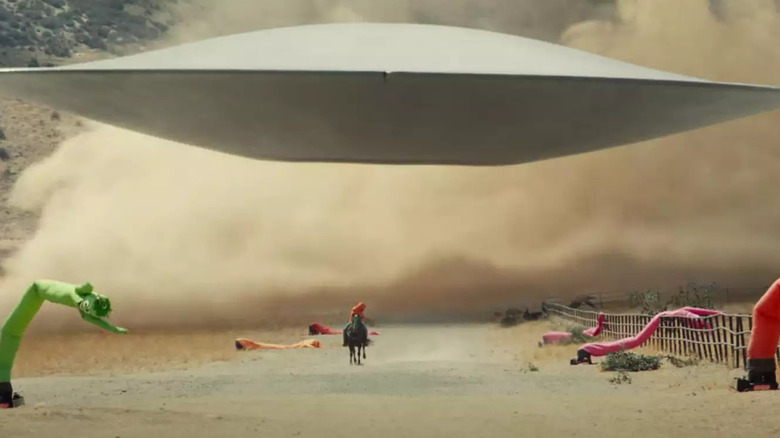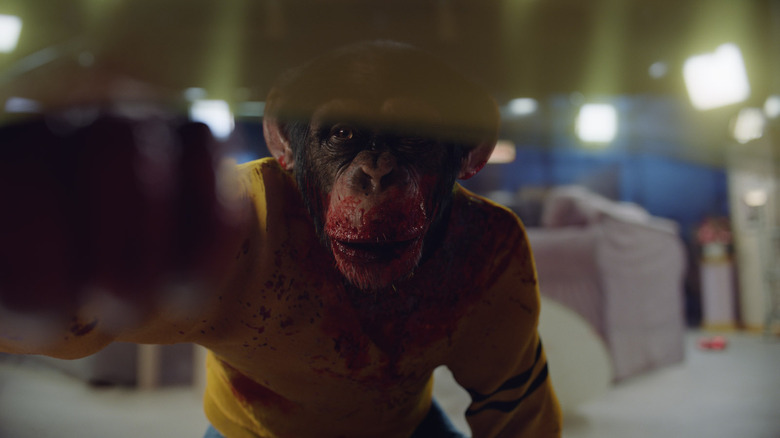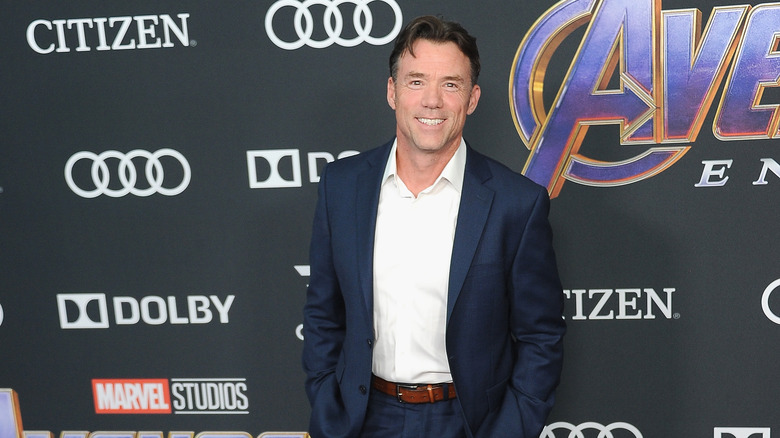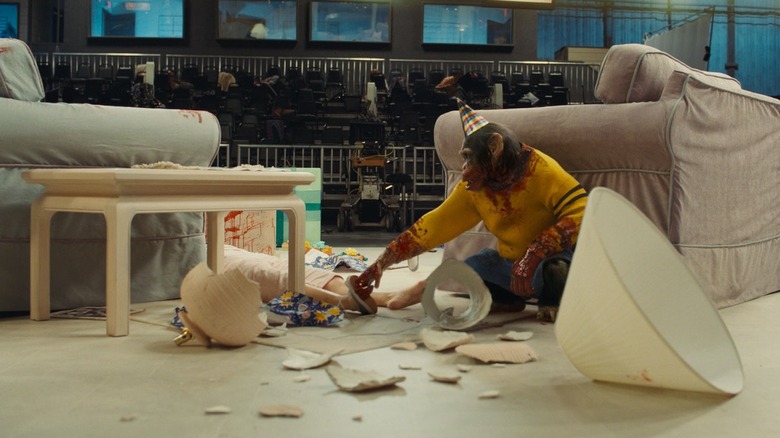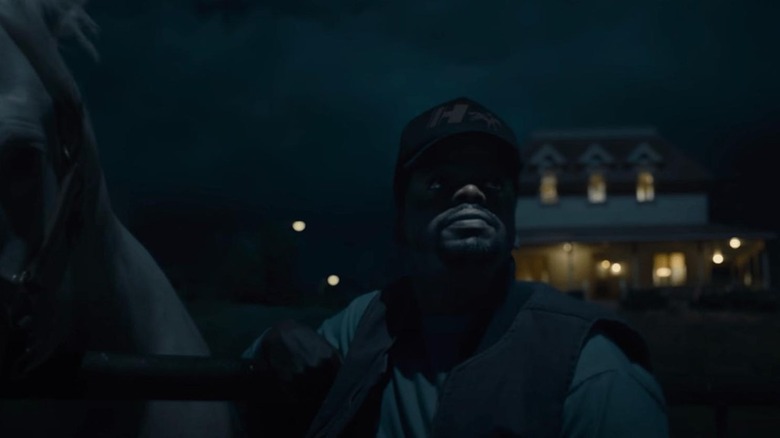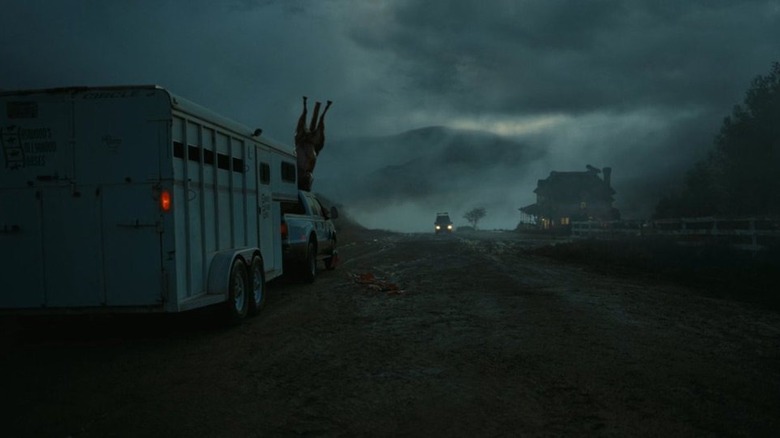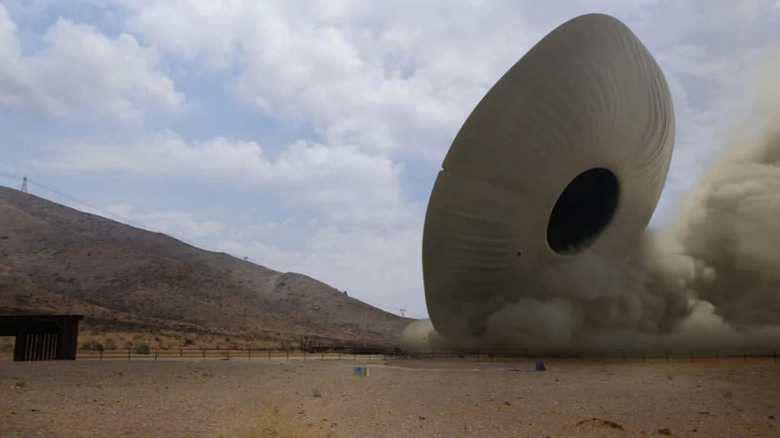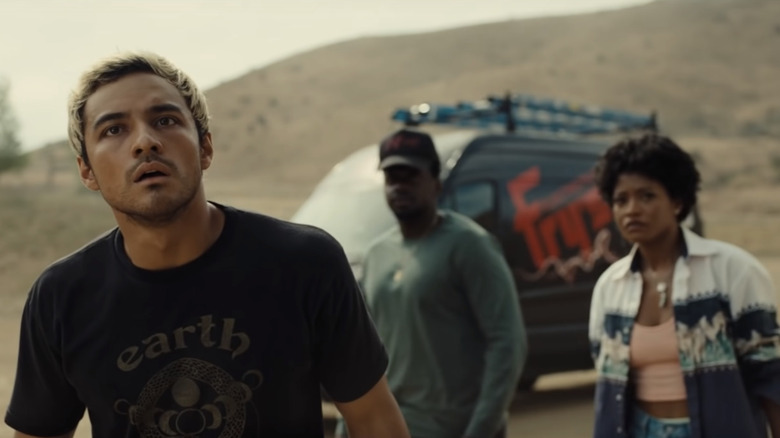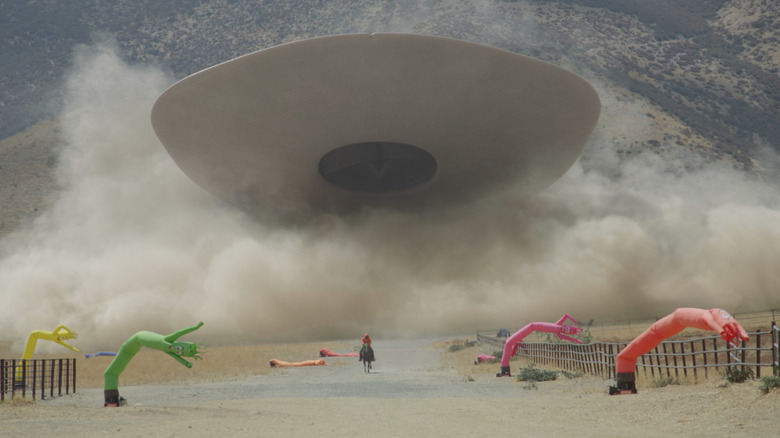What Nope Really Looked Like Before Special Effects
As Hollywood seems more intent with each passing year to focus predominantly on sequels, reboots, and continuous franchises, it's always refreshing when filmmakers strive to create something truly original. Time and again now, Jordan Peele has proven to be one of those directors, and that's more true than ever with latest work, the horror film "Nope." The movie features a unique, gigantic monster known as Jean Jacket, which terrorizes from the sky, camouflaging itself and successfully hiding amongst the clouds, making it a unique beast both frightening and fascinating to watch on screen.
To instill the fear in the audience that the filmmakers wanted, the scenes with Jean Jacket required a ton of close collaboration between visual effects supervisor Guillaume Rocheron and cinematographer Hoyte van Hoytema. What they were able to brilliantly pull off was to control everything that viewers see, doing it so naturally that it's difficult to truly discern the extent to which the footage was manipulated. The clever methods used go far beyond just the scary moments with the flying creature, though, meaning that most of the movie looked extremely different before CGI, infrared, and other types of tech came into the picture. Let's see how the horror hit appeared before the talented crew completed their impressive work.
The Jean Jacket creature was designed in its final form first
The unconventional monster of "Nope" called Jean Jacket was designed in a somewhat unusual manner by doing everything backwards. In an interview with Befores & Afters, visual effects supervisor Guillaume Rocheron explained, "It was a really interesting design process. Jean Jacket, the alien entity, transforms, which meant that we actually designed it the other way around. That is, we started with the final 'transformed' form instead of starting from its initial shape."
As a bizarre being able to move effortlessly through the skies even in its humungous, climatic shape, Rocheron and the creative team aimed for biological features unlike any other in the environment it inhabited among the clouds. When talking with SYFY Wire, the visual effects pro said that they wanted Jean Jacket to look like the creature was "made entirely [out] of simulating large pieces of cloth." He also added, "The purpose of its skin is to harness the wind and ride it. So, we just launched the biggest cloth simulations we've ever done." Wide shots of both the landscape and the skies were then required to display the gigantic monster in all its unfurled glory with CGI.
The designers were eventually convinced to study jellyfish
As Guillaume Rocheron and the other designers brainstormed how Jean Jacket would appear in "Nope," the goal was to create a creature with actions similar to a predator found in nature, which is why it expands its body dramatically when it feels threatened (per Nerds & Beyond). A crew of experts from various fields were also brought on board for consultation during this process, which ultimately led the filmmakers in a direction that they initially resisted. The special effects chief admitted that the team did not want the main monster to resemble a jellyfish, but it was Professor John O. Dabiri at Caltech who convinced them to go for it.
Stylistically, the creative team may have had other options in mind at first, but in terms of physics and biology, using the sea creature as a model just made too much sense. Rocheron explained the result of Dabiri's advice to SYFY Wire. "We learned through him that the jellyfish is basically the most efficient animal in the ocean," he said. "It uses barely any energy to move, to eat; all its body parts and everything is very efficient. It rides water currents and uses very, very little energy to do so. It inspired us a lot: 'Okay how do we do apply that to a wind creature and how do you make it efficient?'"
All of the skies were fake
After watching "Nope," many audience members would probably be shocked to discover that the seemingly natural California setting, with a classic Western desert serving as a focal point, was heavily modified with special effects. Guillaume Rocheron revealed to The Wrap, "Any time you see the sky in the movie and it's a lot of time in the movie, it's never real."
Oddly enough, to make the movie look as genuine as possible, the filmmakers needed to control every aspect of what viewers saw of the skies on screen. The visual effects supervisor continued, "They're basically a movie set. For each encounter, it's like, they need to do specific things and have specific movements, layout, formation." He then added, "Our artists could just put clouds where we wanted to and they were in a simplified form, but you could stage your action like a digital LEGO set."
So basically, the digital work of art was placed over actual footage of the skies and rendered to blend in as much as possible. And since all the shots were made during the California summer, Rocheron and the crew did not have to worry about genuine clouds getting in the way in the clear blue expanse that was like a blank canvas.
Real dust clouds were created with a helicopter
There is no denying that the filmmakers of "Nope" relied heavily on CGI, sometimes in unexpected ways. However, the crew did strive to film every scene possible with practical effects first, giving the footage a solid basis in realism to later augment with computer animation.
A key example of the movie's implementation of real-world imagery can be found in the massive dust clouds formed by Jean Jacket's flight over the arid soil. Guillaume Rocheron revealed to SYFY Wire, "When we were filming, we had a helicopter that was literally there to act as a giant fan to move dust all around. We got dusted on for weeks and weeks of filming. I found dust in my pockets for like two months after we finished filming."
The practical aspect not only gave the movie a more authentic look, but it was also helpful with scaling. As a huge cloud appeared, viewers were more able to discern how truly gargantuan the soaring entity was — basically the size of an Airbus A380.
A nightmare inspired the horrific Gordy scene
As if the unescapable terror from above was not enough to freak out viewers of "Nope," there is also the brutal massacre carried out by Gordy the chimpanzee in a flashback that's both jarring and deeply unsettling. Yet the chaotic nature of the scene becomes even more emphasized when the animal instantly shifts his demeanor to offer a friendly fist bump to the young Jupe hiding beneath the table, before the animal is then slain with a bullet to the head.
For writers, inspiration can come from anywhere. A great source is dreams — or preferably nightmares, for the horror genre. Such is the case for this disturbing moment of film, which is based on a nighttime terror Jordan Peele experienced several years before, in 2014 (per The Wrap). The director posted on Twitter at the time, "Dreamt that a baby chimp attacked some people then ran to me and hugged me all scared. I woke up with tears streaming down my face. #bruh."
Actor Terry Notary played Gordy the chimpanzee
As is often the case with major CGI characters, there's a human performance at the heart of Gordy the chimpanzee in "Nope." It was not the first role of this kind for Terry Notary, who has also done similar simian work in the recent "Planet of the Apes" movies and "Kong: Skull Island." Several layers of realism were implemented into the graphic scene to increase the terror, beginning with the actor performing the scene for real while the footage was shot. Guillaume Rocheron realized that a motion capture suit was not the way to go, so the head of the SFX told The Wrap that he decided, "I think we should probably really put him in the Gordy costume."
So, as Notary rampaged on the set of the fake TV studio, the actor was able to get more into his character. Rocheron added, "As he was performing, he could really like touch everything and be at the right size and be like the chimp. It was really trying to create an environment that would give us the most truthful performance and most comfortable environment for Terry."
The fictional TV studio set was manipulated for the right scale
Along with the performance of talented actor Terry Notary, another element of the Gordy flashback in "Nope" that makes the scene appear more realistic is its dramatically altered set, which would have been practically unnoticeable for most viewers. When talking with Befores & Afters, Guillaume Rocheron revealed, "We actually built an oversized set. We made it 30% bigger, so when Terry was standing in the set next to the sofa, he would be at chimp scale, basically."
The clever cinematographic techniques did not end there, as the visual effects supervisor added, "Even the little girl, Mary Jo, who is a teenager in the show, we found a 6'2″ stunt woman who was basically 30% taller than her and put her there." The final, chilling practical effect was the fake blood the actor spread to the couch while he moved on set. All of these physical aspects were later augmented with computer graphics — with the transformation of Notary into Gordy obviously being the biggest part of that — but the realism at the core of the scene feels palpable.
The night scenes were filmed during the day
With how good the CGI work is for the artificial clouds throughout "Nope," it may be no surprise that the SFX crew took it a step further when creating the supposed nighttime scenes. Guillaume Rocheron worked very closely with cinematographer Hoyte van Hoytema, who captured the footage using two cameras during the day with the bright sun shining above. Shooting "day for night" is a vintage filmmaking technique, but the "Nope" team found a whole new way to do it, with striking results.
The reason for the unique technique is the fact that anything filmed at night — with a genuine lack of light, as one might find in the desert — would be way too dark on screen. The special effects supervisor explained the thought process to Nerds & Beyond, saying, "We were like, 'Well, what if we shoot the night scenes during the day with infrared cameras, because infrared cameras, they make the blue sky black and they show you contrasts, kind of the way you see at night.'"
One minor issue was that infrared removed all the color, but that's where the other camera came in, filming the same shots simultaneously. Rocheron continued, "A little bit like [how] you colorize a black-and-white movie, you know, when you restore them. Except that this time around we didn't have to kind of invent the colors because we literally filmed them, so we knew what the colors were." The end product looked radically different than before the footage from the two cameras was merged, but just like the daytime shots, it gave the filmmakers the ability to show the audience exactly what they wanted them to see while Jean Jacket stealthily lurked in the dark sky.
The raining blood had to be CGI
One of the most interesting (but disturbing) scenes in "Nope" was again created through a great mix of both practical effects and computer imagery. For the scene in which Jean Jacket expels the belongings of the victims it's gruesomely inhaled and digested over the house of the protagonists, the crew physically dropped loads of unsettling material on the building. When talking with Nerds & Beyond, Guillaume Rocheron explained, "We kind of had them throw a lot of debris for real, practically, from cranes and things like this. And then blood, you know they created like blood/goop that they could just drop on the windows and all these things."
But the fake blood was simply not enough to pull off the level of terror that the filmmakers wanted for the horrifying moment. The special effects supervisor told SYFY Wire, "There's no way that you can build something that will do that at that scale. It's impossible, so we simulated that giant, circular waterfall. And then the blood falling on the house, all that is simulated in CG."
The inside of Jean Jacket was designed last
In the grand finale of "Nope," Jean Jacket unfurls into its horrifyingly huge, yet majestic shape to intimidate its tiny prey. The design of the monster is an integral part of the climatic faceoff with the protagonists, so it was a big priority for the creative team at the beginning of production. Next, they had to develop the more frequent flying saucer shape the creature takes to hunt throughout the film. At this point, Guillaume Rocheron and the crew realized that they had to shift their focus to one last pivotal perspective. The SFX team leader told Nerds & Beyond, "We never really considered the inside as we were doing the original pieces of design."
From what the designers had developed so far, there was a logical approach. "Basically, I kind of jumped on this idea that ... it's this kind of like folded origami," Rocheron continued. "So, when you go inside Jean Jacket, what you're seeing is the folded origami version of what's gonna come out, right, and how it's gonna unfold. And starting there, it's basically how all the structures got designed and compressed."
Simulated cloud shadows stalk the characters
Out of all the impressive visual effects in "Nope" that blend in so well with the natural surroundings that they go completely unnoticed to most audience members, possibly the most subtle of all occurs throughout the entire film. The filmmakers wanted viewers to have the skies above in the back of their minds, so the special effects team created a constant reminder that was far less grand than a showy recreation of the great blue, yet was still effective.
In an interview with The Art of VFX, Guillaume Rocheron described the clever method, saying, "To suggest the looming presence of the sky, you'll notice that there are always cloud shadows driving on the ground. We applied that throughout the film whenever the clouds were above us, even in scenes where there was no encounter with Jean Jacket." Even though it was only a minor alteration, the added shadows are a great way to subconsciously influence the audience into feeling a continual dread for the inescapable alien presence.
Not all of the inflatable tube men were real
With an aerial monster riding upon gusts in the sky to devour its innocent victims, the wind is a persistent presence throughout "Nope." As one of the ways to further showcase the atmospheric effect, the filmmakers incorporated comical inflatable tube men that make appearances in the epic showdown with Jean Jacket.
It may be somewhat surprising to learn that not all of the artificial dancers were genuinely there, but what is more impressive is the level of detail the crew put into yet another aspect of the practical effects by creating an elaborate set-up for the real inflatable figures. Guillaume Rocheron told Befores & Afters, "We did just a few in VFX. They designed an incredible radio control system where you had a hundred of those. It could be programmed with patterns and waves, or it could be like, 'Turn on B52.' Our gaffer just did an insane job at rigging that thing. It was amazing, actually, and very surreal."
